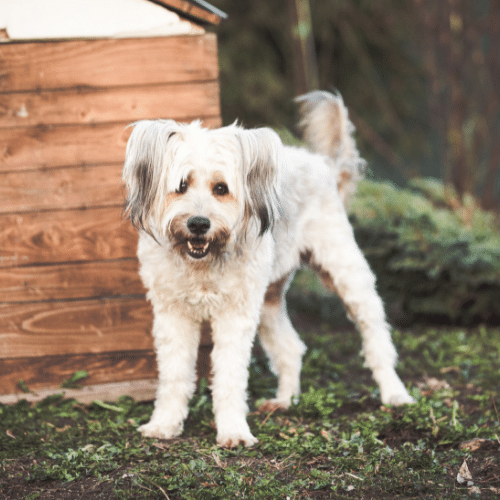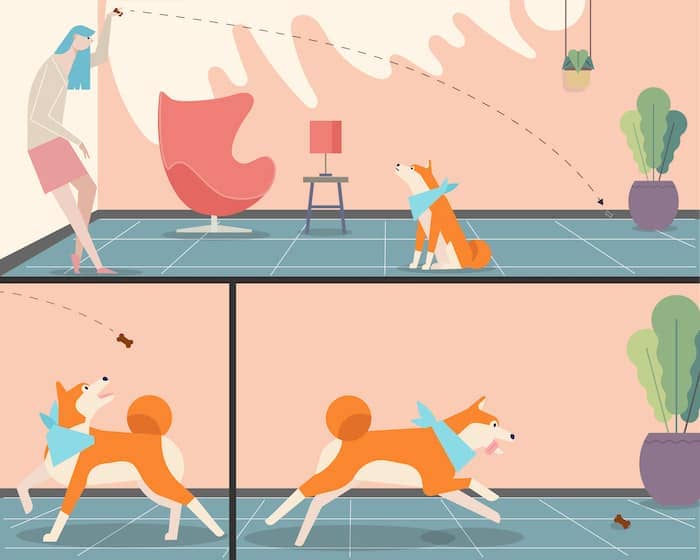Be the leader your dog needs.
New studies have observed that dogs need a leader. While their closest ancestors, wolves, often cooperate, canines prefer to submit to the leader in search of protection. In your rescue dog’s new home, you’ll need to establish your leadership to show the dog that you can protect him or her. This has nothing to do with the outdated concept of “alpha dog” training but has everything to do with establishing trust with your pet. It requires you to pay attention to your dog’s emotions and step in when necessary. Dogs will often return the favor in protecting or comforting their owners.
Why Is My Rescue Dog Acting This Way?
Dogs, like people, each have their own personalities. Some traits can be inherited through genetics. Others are the results of the dog’s environment.
If you don’t know much about your rescue dog’s history, there’s no way to tell exactly what they have been through. Dogs wind up in rescues for various reasons, and not all of them are pleasant.
Dogs that have been neglected for most of their lives are not going to have the same personalities or temperaments as dogs that have been nurtured and loved since they were puppies. At least, not right away. Adopting a rescue dog saves a life, but it also may mean the dog needs more time to adjust to a new way of living. After all, you can’t explain to them what’s happening.
If the neglect happened during the dog’s first weeks of life, this can cause lifelong neurological issues. Proper socialization must be done at the right time, or else it can be very hard for a dog to overcome their fear of new people and situations. While some dogs might love sitting next to you at an outdoor cafe, traumatized or severely abused dogs can view this as a torturous experience. Not every dog will react the same way to every experience.
If a dog has been abused, it’s only natural that they are mistrustful of humans, since humans were the source of his pain. The dog doesn’t know that some humans might not be abusive. They’ve learned that they have to be wary of people to try and protect themselves.
Even dogs that didn’t have a horrible past might find themselves terrified in rescue facilities. Some dogs are just more fearful by nature than others. If you bring a dog home who was well-loved and cared for before you adopted them, it doesn’t mean they won’t need time to adjust.

You may have visions of adopting a dog who loves to run errands with you, is pleasant with people and other animals, and is sociable and confident. That’s a lot to expect from any dog, let alone a rescue.
The best way to get a well-rounded, properly trained, and socialized dog is to have them from a puppy and start training classes as soon as the dog is vaccinated and can be around others. Even then, it’s important to remember that every dog is different and has their own likes and dislikes.
Before you adopt, consider if you’re willing to drop your expectations based on your specific dog’s needs. When you commit to a dog, you’re saying you will accept and love that dog exactly as they are and do what you can to help them be the best they can be. When you adopt a dog, you’re saying you will consider their past and allow them to adjust at their own pace. It’s important to not hold them to any preconceived notions of how they should act.
After all, you didn’t get the chance to help them flourish since they were a puppy. Now, you have a dog who doesn’t know how to react in their new environment and you’re all they have to rely on.
Normal for your dog will be their way of acting once they’ve adjusted and feel comfortable and safe with you. Then their true personality can finally shine.
Play Treat and Retreat

This game is somewhat similar to the Plate Game above, but it’s a bit more dynamic, which can introduce added difficulty.
The game works like this – if your dog looks at you or moves towards you, your job is to toss a tasty morsel behind her. She’ll turn around to go eat it, and then will ideally turn back to you for another treat toss. This game generally goes well if you’re sitting down and therefore stationary.
Quickly, your dog will learn to approach you (or other strangers) of her own accord, then go get the treats. Your dog also learns that she can retreat if she’s nervous, helping to reduce the likelihood of defensive or fear-based aggression. Over time, your dog can learn to fully approach people through this game.
Old advice has taught owners to lure dogs to us with food. Unfortunately, food can tempt dogs into scary situations where they feel pressured. Once the dog eats the food after being lured in, they get scared and may lash out. Many people also can’t help themselves but to try to cuddle the dog after luring her in – a huge no-no!
Instead, let the food act as a motivator that pushes your dog in the ideal area outside of the comfort zone that’s still safe. The goal is to bring your dog outside of her comfort zone just enough, but not so much that the task becomes overwhelming or frightening.
This concept applies for humans too – new, challenging experiences should always happen within that magical orange area.
Building Trust in a Fearful Rescue Dog
Did you recently adopt a dog from the shelter? Is your adopted dog showing signs of trauma? Is settling in more challenging than expected? You are not alone – many newly adopted dogs struggle with adapting to their new home and schedule, and some might even show signs of separation anxiety or trauma.
The good news is that with the right approach, patience, and consistency you can help your dog adjust to their new life and start to trust you!